Now in its sixth year, this program will recognize 14 technologies representing 13 companies: 2H Offshore; Cameron-Nautronix; ProPure AS; Reelwell AS; Schlumberger Subsea Surveillance; Specialized Products; Technip France; US Synthetic Corp., a Dover Company; VetcoGray, a GE Oil & Gas Company; Weatherford International, LTD; Welltec; and WesternGeco, a business unit of Schlumberger.
Winners are selected on five criteria. First, the technology must be new, i.e., less than two years old. Second, the technology must be innovative, original, groundbreaking and capable of revolutionizing the offshore E&P industry; e.g., an improvement in efficiency of an existing motor would not be considered unless it had the potential to change the way in which the motor would be used in the industry. Third, the item must have been proven through either successful prototype testing or full-scale application. Fourth, it must have broad interest and appeal for the industry. Finally, the technology must make a significant impact, providing sizeable benefits beyond existing technologies.
Baker Hughes Inc. receives two Spotlight awards for fourth consecutive year
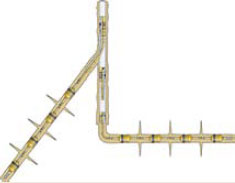 |
|
Baker Oil Tools’ Frac-Hook multilateral system.
|
|
Baker Oil Tools received an award for its TORXS expandable liner hanger system. Operators desire the ability to execute an activity within the planned time and budget, with minimum risk. Liner installations can challenge this when complex hole environments, equipment limitations or undependable methods exist. Conventional liner hanger systems are well proven but become limited in functionality as hole conditions become more complex. Expandable liner hanger systems, albeit unique in concept with few exposed parts, are operationally primitive with inherent cementing risks. Baker Oil Tools recognized both the advantages and the disadvantages of these two systems and developed multiple new technologies that exploit the benefits of each into a single integrated system called TORXS.
A variable-diameter swage enables the TORXS running tool to expand the liner hanger before displacing cement. Expansion of the hanger component is easily controlled and does not reduce the system’s annular flow area. Packer setting occurs after displacing cement and is not dependent on plug bump. The system is robust, has superior torsion limitations and uses balanced hydraulics so that the liner can be safely rotated and circulated down, without risk of premature activations.
Baker Oil Tools also received an award for its Frac-Hook multilateral system. Producing gas in tight shale formations often requires major pumping investments. Traditionally, a driller didn’t have many good choices when fracturing a tight gas well. One option was to simply pump frac fluid into the open hole and hope for the best, which resulted in frac fluid flowing mainly to the area of least resistance, reducing production along the rest of the wellbore.
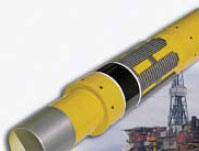 |
|
Baker Oil Tools’ TORXS expandable liner hanger system.
|
|
The new multilateral system allows operators to accurately pinpoint fracture placements, provide greater access and control of laterals. Also, the separate components are time- and cost-saving products on their own; combined, they offer the most cost-efficient and accurate stimulation system available.
Subsea electronics module offers better communication
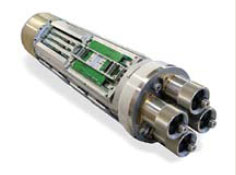 |
|
VetcoGray’s fifth-generation subsea electronics module.
|
|
VetcoGray received an award for its SEM5, a fifth-generation subsea electronics module for use in subsea production control systems. The SEM offers new levels of open architecture IP-enabled communication capabilities through the application of a truly modular design approach, realizing industry subsea plug-and-play ambitions.
An extensive variety of modem options in terms of type and speed are designed to satisfy any customer’s bandwidth and offset requirements. The SEM also supports industry-standard interfaces SIIS 1-3 and IWIS as well as full sensor interface capability. A 32-bit micro controller using a commercial RTOS processing module can be fitted as daughterboard to any internal electronic module that requires processing power, each with its own independent IP address directly addressable from the surface. All internal cards have the same format, and the majority can be fitted in any backplane slot.
Inherent within the design are measures to enhance SEM5’s resilience to future obsolescence issues with electronic components, an industrywide issue. Enhanced reliability is achieved with thermal management and modeling integral to the design, on-board diagnostics and fault-tolerant I/O. The robust mechanical construction will meet shock, vibration and temperature-cycle requirements of ISO 13628.
Coil shooting enhances WAZ and MAZ techniques
 |
|
WesternGeco’s Coil Shooting technology enables complex FAZ 3D surveys.
|
|
WesternGeco received an award for its Coil Shooting technology. Coil Shooting acquires full-azimuth (FAZ) marine seismic data continuously with a circular geometry using only a single seismic vessel.
Coil Shooting takes geophysics further by enhancing current multi- and wide-azimuth (MAZ and WAZ) acquisition techniques. MAZ and WAZ are proven methods of seismic acquisition for complex geological areas. The MAZ technique involves shooting a survey several times with one vessel, each experiment being on a different heading. The WAZ technique involves acquisition with a number of source and recording streamer vessels. In both cases the result is better illumination, higher signal-to-noise ratio, and improved seismic resolution compared to traditional 3D methods. However, Coil Shooting enables complex FAZ 3D surveys to be efficiently acquired using only one vessel.
By sailing in overlapping circles, a very large number of shot/receiver positions can be created and a single source/receiver boat can produce unprecedented offset and azimuth sampling, which leads to higher-quality images with superior noise suppression. Using Q-Marine technology means that it is possible to sail in circles while maintaining constant streamer separation and achieving accurate receiver positioning. Coil Shooting is therefore not only extremely efficient, but it also delivers data that addresses some of the challenges of imaging complex geologies.
System combines freshwater injection and crude-freshwater mixing
The compact one-shot ProSalt mixer by ProPure combines freshwater injection and crude-freshwater mixing by imposing a homogeneous shear stress of the dispersed fresh-crude flow. A homogeneous freshwater droplet size distribution results, resulting in a more separable freshwater-crude mixture and correspondingly better utilization of the injected freshwater. The ProSalt, equipped with an actuator-driven mixer cylinder internal, can handle any turn-down crude flowrate.
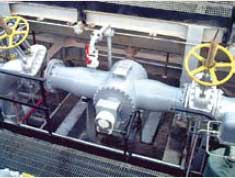 |
|
WesternGeco’s Coil Shooting technology enables complex FAZ 3D surveys.
|
|
For the conventional desalting process of crude, static mixers such as globe valves have been used for mixing of crude with injected freshwater. This mixing method often results in consuming high quantities of wash water and chemicals with relatively low mixing efficiency. The static mixer pressure drop represents a considerable pressure drop and risk for poor crude-freshwater separation in the downstream separator.
Pulse technology extends battery life
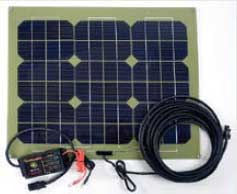 |
|
Specialized Products’ Pulse Technology battery maintenance system.
|
|
Specialized Products received an award for its Pulse Technology battery maintenance, conditioning and charging. Considering that 80% of fleet and equipment battery failure is caused by battery plate sulfation and related failure modes, the newest development in Pulse Technology is the solution to battery-related fleet sustainability. This technology, when implemented through the new SP-25 solar product, is the newest lead acid battery charging, conditioning and maintenance product available on the market today. Through two independent power circuits, the SP-25 combines a highly intelligent interactive battery charging regimen with the application of a high-frequency pulse into the battery. The high-frequency pulsing action provides an electro-mechanical scrubbing activity on the surface of the battery plates. This action removes and inhibits growth of sulfation crystals on the surface of the battery plate and puts them back into electrolyte solution. This technology has been proven to extend battery life by up to five times. Fleet and equipment sustainability is maximized, and downtime due to battery-related failure can be virtually eliminated through use of this product.
Dynamic curvature sensor detects problems early
2H Offshore received an award for its Integristick, which incorporates several strain gauges inside a corrosion-resistant metal housing; it measures biplanar curvature changes to subsea structures to a resolution of 1 micro-strain, creep free. The device is optimized to capture the smallest bending moments of a structure during the life of the field and provides vital information about the performance of the structure under harsh environmental conditions. Use of the device is critical in detecting major problems early enough to prevent failure, potentially saving millions of dollars in operational downtime.
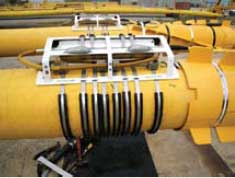 |
|
2H Offshore’s Integristick dynamic curvature sensor.
|
|
The sensor features ultra-low power consumption and is designed to interface directly to the Integripod that contains electronic components and batteries to supply power, communication and data storage capabilities. It can be used as a stand-alone battery-powered unit, or as a permanent online system. It can be deployed onshore or offshore, by diver or ROV, in water depths up to 9,800 ft. The compact, lightweight and robust design allows it to be applied in virtually any short space environment.
Power suction tool more effective at debris recovery from producing wells
Welltec received an award for its Well Cleaner Power Suction Tool (PST). Sand cleanouts are typically performed with either slickline bailers or Coiled Tubing (CT). In high angles, CT cleanouts can break down bridges but rarely achieve circulation rates to remove all the sand, leaving it spread over the wellbore, while sometimes forcing sand back into perforations. The Well Cleaner PST is run on electric line, and is more effective at recovering sand and debris from producing wells.
With its large drawdown, this new system is able to lift sand into long bailer sections and is capable of bailing up to one metric ton of sand per run. By comparison, slickline bailers recover between 4 and 9 L of sand. The new cleaning system provides a cost benefit over “heavy” pipe solutions due to less mobilization of people and equipment.
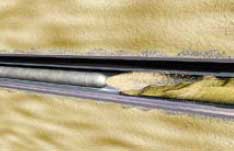 |
|
Welltec’s Well Cleaner Power Suction Tool.
|
|
The Well Cleaner PST takes in well fluid and solids, filters out the solids and returns cleaned fluid to the wellbore. It is a flexible bailer system with sizes ranging from 31⁄2 to 7 in. OD. Different inlet nozzles can be applied to pick up sand on the low side as well as break through massive sand bridges that have built up.
Subsea monitoring systems record buckling
Schlumberger received an award for its subC-strip and subC-collar. Chevron determined that the only practical way to record buckling on its Tahiti development was to adopt the subC-strip and subC-collar integrity monitoring systems. These 600-ft sensors continuously monitor the entire buckle shape, pipe axial and hoop strain and temperature, providing a complete picture of buckle response to operational production cycles.
The subC-strip uses a sensor strip attached to flowline joints in the buckle region that follows the shape of the pipe as it bends. The strip contains a series of embedded optical strain sensors that measure the curvature profile along the buckle. The Tahiti subC-strip is designed to fasten on top of the insulated flowline.
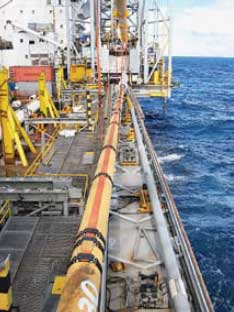 |
|
Schlumberger’s 160-ft subC-strip on quad joint about to be deployed.
|
|
The subC-collar is a clamp design that fastens around pipe; the embedded optical sensors are oriented in the axial and hoop directions to measure axial-strain and internal pressure fluctuations in the flowline. The subC-collar is attached to the flowline and over-molded using standard field joint coating procedures.
Data is transferred to the surface via a field umbilical using a low-power optical modem communication system to the topside data acquisition system. It is captured on the Tahiti spar, where real-time measured and derived values are presented in tabular and graphical form.
In addition to the first deployment above, both elements of the measurement system can be retrofitted by ROV to existing subsea structures.
Industry’s first one-trip Level 4 multilateral system
Weatherford received an award for its OneTrip Starburst Multilateral System. The system is particularly well-suited for wells in mature fields, where production rates are declining. The OneTrip StarBurst system is designed with a hollow whipstock that does not require retrieval. Once the system is run into the well, the casing exit is milled and the lateral is drilled and completed, the hollow whipstock is left in place. This process enables the operator to return to the location later to perforate and access reserves below the isolated zone—without jeopardizing the integrity of the zone that was previously drilled.
The system consists of three key parts: a packer, a concave and a milling system. The packer on the bottom of the whipstock seals off and isolates the main bore while the new lateral is drilled. This process enables the operator to use heavier muds to drill the new lateral without concern about damaging the previously drilled reservoir below—which may be partially depleted.
Once a window is milled and the lateral is drilled, a liner is run across the face of the whipstock and the string is cemented in place, at which point the hollow whipstock is totally isolated. The operator can begin perforating, running expandable sand screens or conducting other completion configurations to begin production from the new lateral.
When the operator is ready to produce the main bore, low-dose radioactive tags—which would have been previously installed in the hollow whipstock—are used to depth correlate. Perforating equipment containing a gamma tool is used to identify the location of the tags and ultimately the hollow whipstock’s perforating zone, which is typically a relatively short space of about 9 ft long.
 |
|
Weatherford’s OneTrip Starburst.
|
|
Diamond radial bearings offer greater abrasion resistance
US Synthetic Bearings has developed a diamond radial bearing capable of operating in drilling fluid environments. It is resistant to abrasion and provides bearing lives that are 2–8 times longer than tungsten carbide or other hard metal bearings. Polycrystalline diamond pads are formed, machined and placed to form a diamond radial bearing that runs smoothly on polished precision diamond surfaces. Despite precision clearances, these bearings can withstand the rigors of drilling fluid lubrication and dynamic downhole environments. These bearings find application as the near-bit bearing set in mud motors and turbines. In these applications, bearing life has been extended and bearing reliability improved. Diamond radial bearings have also found application in power generation and rotary steerable tools where bearing life has been at least tripled when compared to conventional tungsten carbide bearings. These bearings are available in diameters of 1–10 in.
 |
|
US Synthetic’s diamond radial bearings.
|
|
LNG loading system allows new transfer methods
Technip France received an award for its Amplitude-LNG loading system. LNG transfer in dynamic offshore conditions has required the development and qualification of a new technology related directly to heavy-duty cryogenic flexible pipe systems. The flexible pipe, as the key component of the Amplitude-LNG Loading System (ALLS), opens up new methods for the transfer of LNG in offshore and near-shore marine conditions. The cryogenic flexibility is based on an internal stainless steel flexible bellows that ensures leakproofness and compatibility with LNG. An insulation layer ensures that the external face of the flexible pipe has no ice buildup during LNG transfer. An intermediate layer prevents ingress of humidity and provides a double annulus for instrumentation and leak detection purposes, while an external leakproof layer renders the assembly watertight. The ALLS also includes an automatic connection system, designed and manufactured by KSB and Eurodim. The complete system was qualified through a comprehensive test program featuring dynamic testing and operated by GDF Suez with live LNG from an LNG carrier.
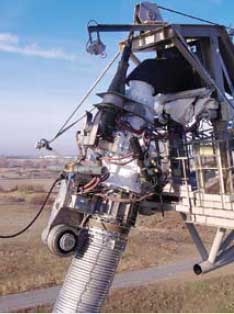 |
|
Technip’s LNG loading system.
|
|
New method challenges drilling limitations
Reelwell won an award for its Reelwell Drilling Method. The method is based on a concentric dual-drillstring closed circulation system. For increased safety, a dual float valve and a piston secure fulltime pressure control during drilling and pipe connections. The piston prevents the annular fluid from being lost, and also provides the downhole hydraulic weight on bit for increased reach when drilling horizontal sections. Drill cuttings are removed from the wellbore just behind the drillbit and routed back to the surface via the inner string, securing clean hole conditions.
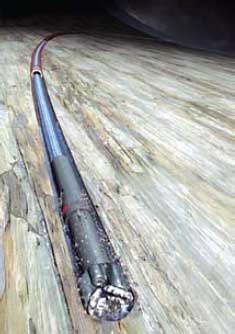 |
|
Reelwell’s drilling method.
|
|
The method secures accurate pressure management and improved well control through closed-loop fluid circulation, making it especially attractive for managed pressure drilling. With all circulation being confined in the dual drillstring, the new method may push existing deepwater limits through riserless drilling.
Acoustic system provides full control for subsea BOP equipment
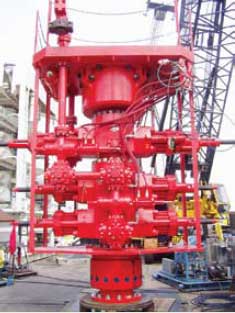 |
|
Cameron and Nautronix’s NASMUX.
|
|
Cameron Drilling Systems received an award for its NASMUX acoustic system providing full control for subsea blowout preventer equipment. The system offers an alternative to traditional multiplexed control systems. NASMUX replaces the command, control and monitoring aspects of a control umbilical with an acoustic system that requires very little topside equipment. As a result, immediate benefits are realized, including: flexibility to transfer the system between rigs quickly and cheaply; increasing available deck space; and reductions in handling and transportation costs.
NASMUX features include high function count, digital readbacks, analog signals for information such as pressure readings and several programmable sequences for single-command activation of sequences such as emergency disconnect. The system is a collaborative venture between Nautronix and Cameron Drilling Systems. 
|
















